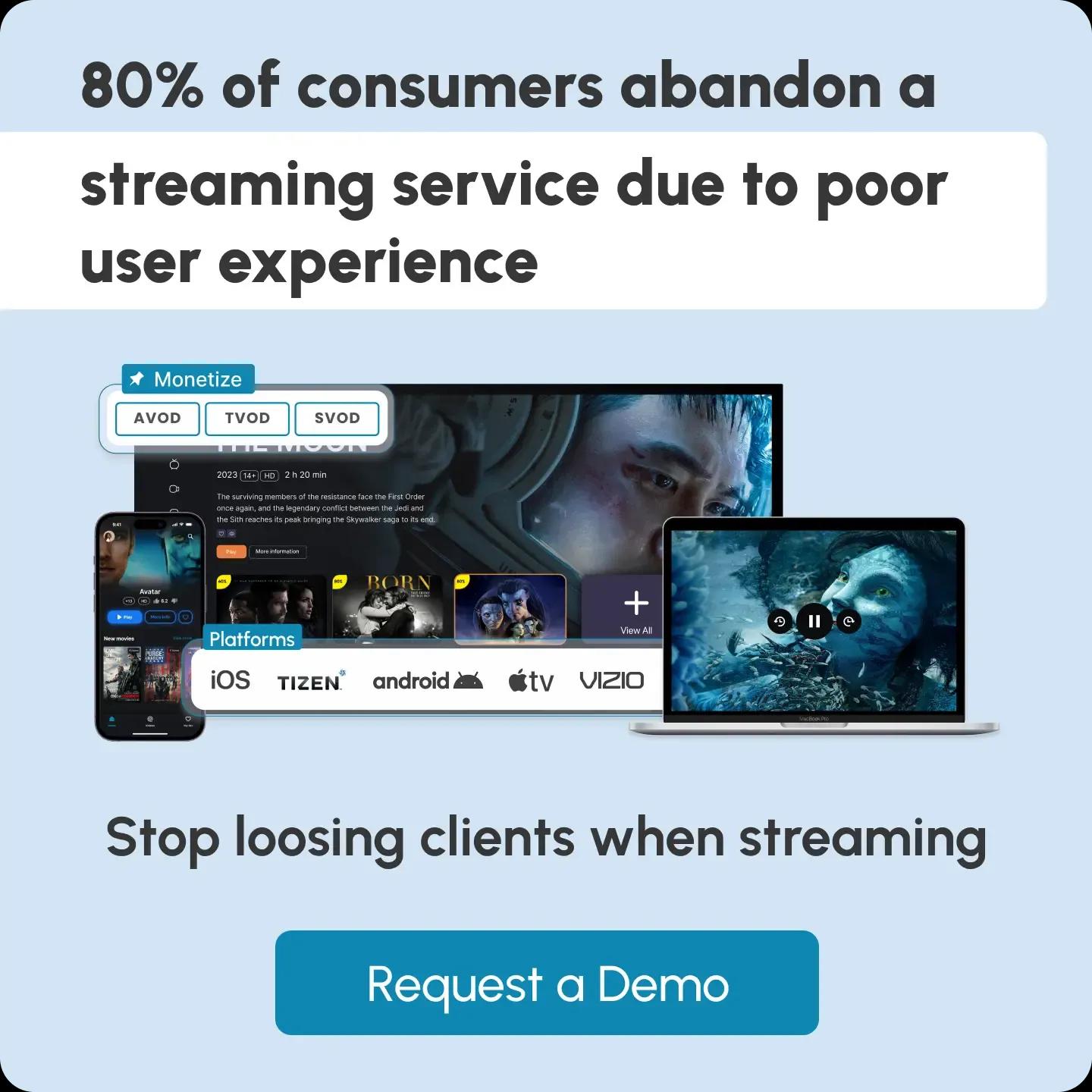
Streaming vs Broadcasting: Types And Key Differences
Although they operate differently, both streaming and broadcasting are essential for worldwide audience reach.
Broadcasting is the term for the distribution of content over radio and television channels to a large audience.
Streaming uses the internet to deliver on-demand content straight to users' devices.
To choose the best way to reach your target audience, you need to know the differences between these two content distribution types.
This article goes over the key differences between streaming and broadcasting. We’ll cover their respective advantages, disadvantages, and applications in many other fields.

Key Takeaways
- While broadcasting is still a consistent way to reach large audiences concurrently, streaming offers flexibility and on-demand access.
- With streaming, you can customize content to fit personal tastes, thereby improving viewer engagement.
- Combining streaming and broadcasting on platforms helps expand accessibility and meet the needs of different audiences.
What is Streaming?
Streaming is a technique for the real-time online transmission of digital media content, allowing consumers to view or listen to audio and video content without needing to download it.
Unlike traditional file transfers, streaming divides media into small data packets that are sent consecutively and played at a fast speed, thereby providing a flawless, on-demand experience. Live, video, audio, and game content platforms, in particular, greatly rely on this kind of content distribution.
Types of Streaming
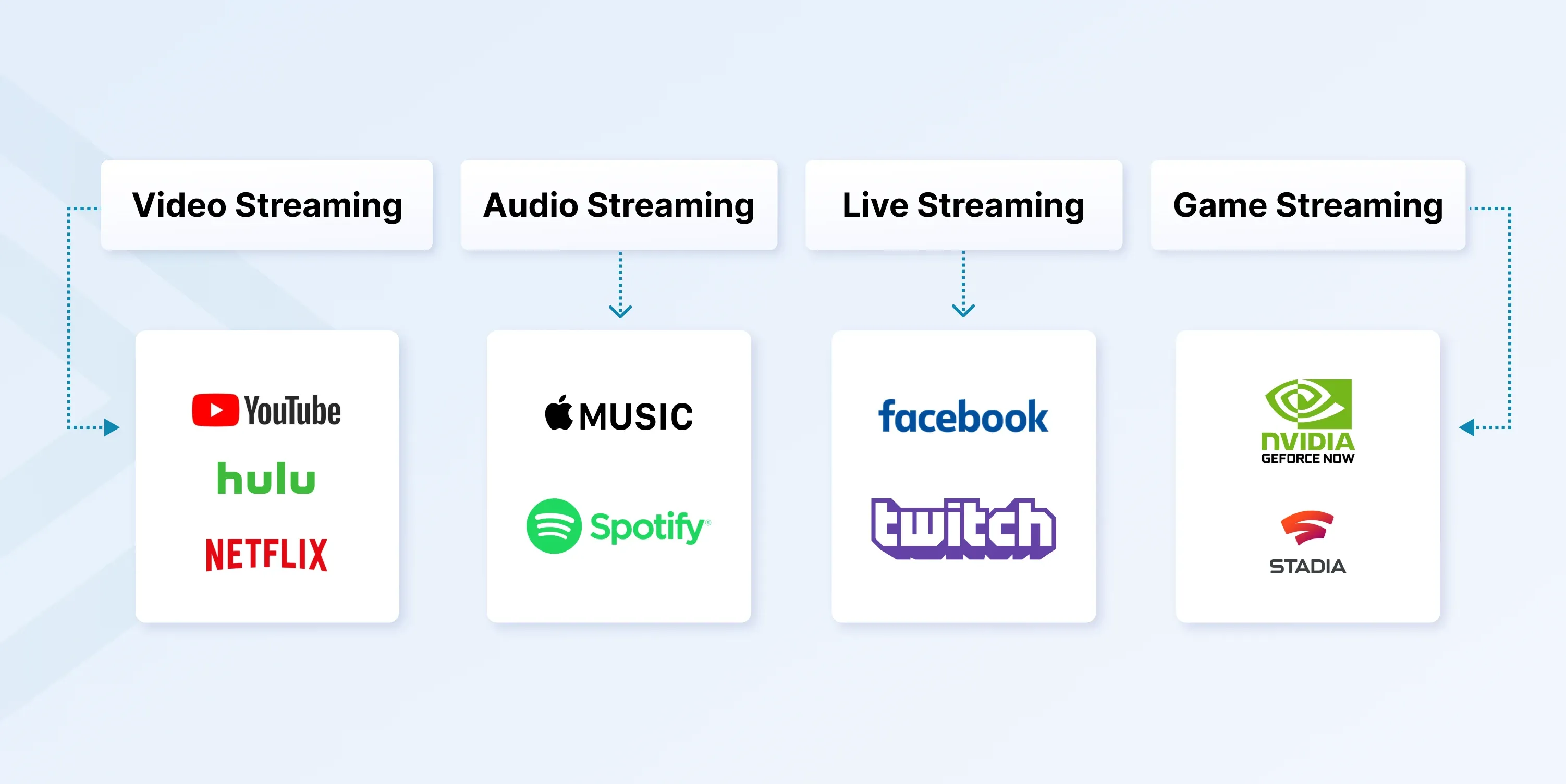 Streaming can be categorized into several types based on the type of content and how it is delivered:
Streaming can be categorized into several types based on the type of content and how it is delivered:
Video Streaming
The most common form of streaming is video streaming, which includes TV shows, movies, and live broadcasts. Platforms like Netflix, YouTube, and Hulu rely on video streaming to reach millions of viewers globally, offering both on-demand and live content.
Audio Streaming
Focused on delivering audio content, this type of streaming includes music, podcasts, and radio shows. Services like Spotify and Apple Music dominate this space, giving users access to vast libraries of on-demand audio content.
Live Streaming
Live streaming enables real-time broadcasting of events, including personal streams by content creators, concerts, and sports. Popular live streaming sites that let viewers see events as they happen include Facebook Live and Twitch.
Game Streaming
This is a more recent version of streaming, enabling consumers to play games straight from the cloud without installing them on local devices. Pioneering this category, services like NVIDIA GeForce Now and Google Stadia make high-end gaming available on a wide range of devices.
Popular Streaming Services
Many well-known platforms in today's media scene now have streaming as their cornerstone.
Leading video streaming company, Netflix, offers a vast range of films, TV series, documentaries, and original content.
Known for both live streaming and on-demand video, YouTube is a go-to tool for companies and creators alike. Emphasizing music streaming, Spotify offers millions of songs, playlists, and podcasts to consumers worldwide.
Twitch is a top live streaming site, especially among the gaming community, where users can view and interact with their favorite players in real-time.
What is Broadcasting?
Broadcasting is the traditional method of distributing audio or video content from a central source to a sizable audience across a one-way communication channel.
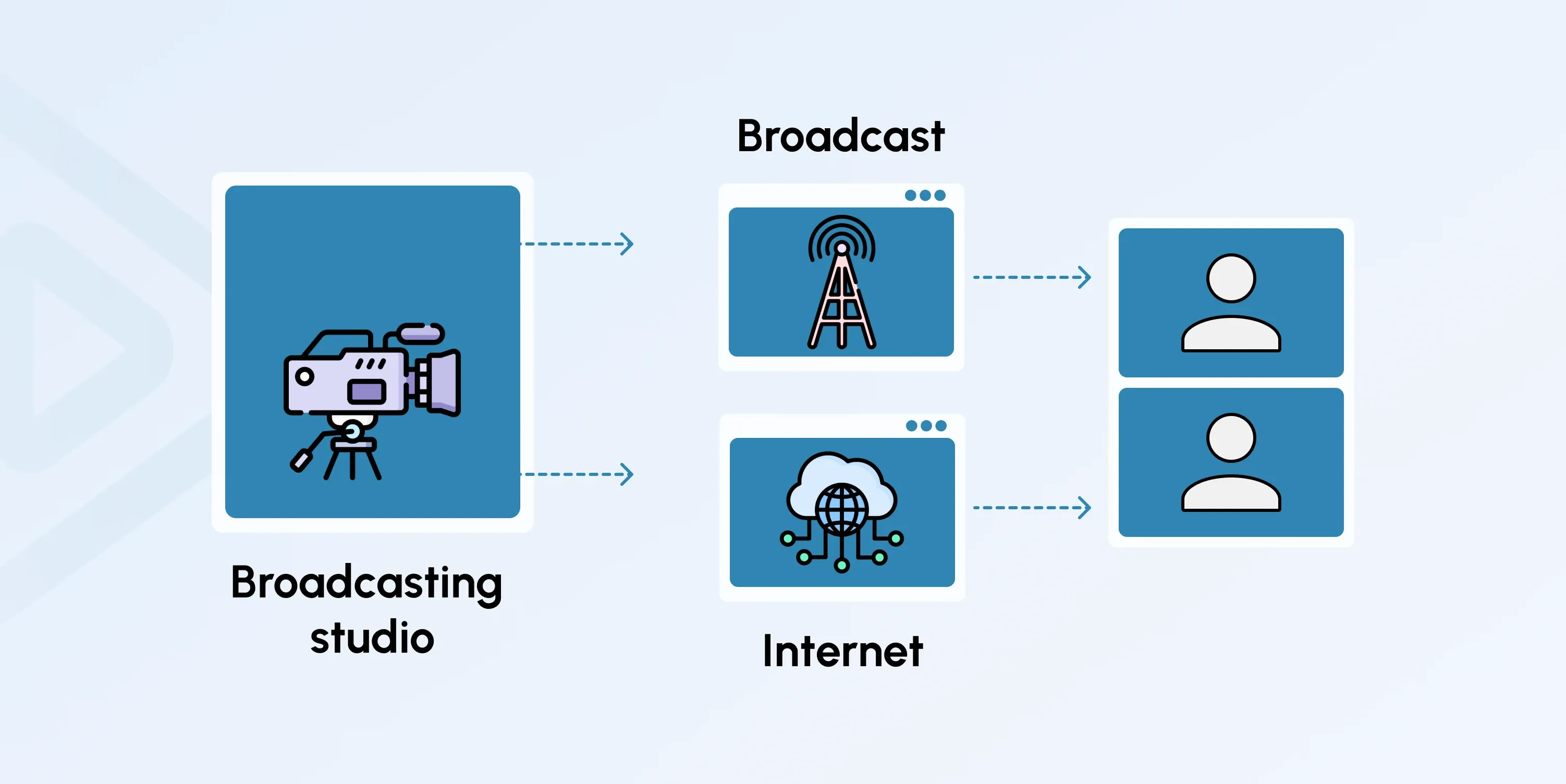 Mass communication is best suited here. Broadcasting simultaneously distributes the same content to all recipients. Usually using radio waves or satellite transmissions, broadcasting lets your message reach several audiences over a large geographical area.
Mass communication is best suited here. Broadcasting simultaneously distributes the same content to all recipients. Usually using radio waves or satellite transmissions, broadcasting lets your message reach several audiences over a large geographical area.
Types of Broadcasting
Broadcasting can be classified based on the type of media being transmitted and the technology used for distribution. Here are the main types:
Radio Broadcasting
Sent over AM or FM radio waves, this is one of the first kinds of broadcasting where audio is transmitted. Audio content includes news, music, and talk shows. The low-cost distribution and accessibility of radio transmission make it still rather popular.
Television Broadcasting
Analog or digital transmissions allow television broadcasts to play video and audio content. Audiences are fed content like news, sports, entertainment, and live events, typically on cable, satellite, or terrestrial networks.
Satellite Broadcasting
While terrestrial broadcasting uses ground-based antennas, satellite broadcasting relies on satellites in orbit. This lets shows cover more geographical ground, including rural or distant regions. Dish Network and DirecTV are among the satellite TV providers that use this approach.
Internet Broadcasting
Internet broadcasting, sometimes referred to as "webcasting," distributes live or pre-recorded audio and video across the internet. Although it’s similar to streaming, internet broadcasting typically shows content to several people at once, often for live events.
Traditional Broadcasting Channels
Distribution of content in broadcasting depends on several channels, especially those generally accessible to the public.
Available on basic radio devices, AM and FM stations broadcast audio content over designated frequencies. To reach regional and national audiences, traditional TV networks employ antennas to broadcast signals that compatible television sets may receive.
From news and entertainment to sports and educational programming, cable TV channels offer a vast spectrum of channels that broadcast programs to consumers over coaxial or fiber-optic cables.
Often with a subscription to either DirecTV or Dish, satellite TV channels offer access to TV broadcasts even in areas lacking cable infrastructure.
Streaming vs Broadcasting: Key Differences
| Aspect | Streaming | Broadcasting |
|---|---|---|
| Definition | Transmitting audio or video content over the internet for on-demand or live access by users. | Sending audio or video signals from a central source to a wide audience via radio waves, satellite, or cable. |
| Content Delivery | One-to-one delivery where each user can access unique content at different times. | One-to-many delivery where the same content is broadcast to all viewers simultaneously. |
| Control Over Content | Users have control over playback, pausing, and choosing what to watch. | Audience follows the scheduled programming without the ability to pause or select specific content. |
| Accessibility | Requires an internet connection; accessible on-demand from any device connected to the web. | Accessible via terrestrial, satellite, or cable signals; requires compatible TV or radio devices. |
| Interactivity | Often interactive, allowing user engagement through comments, reactions, or live chats. | Non-interactive, with no direct way for the audience to interact with the broadcaster in real-time. |
| Content Scheduling | On-demand or scheduled for live streaming; content can be accessed any time. | Follows a fixed schedule with specific showtimes set by the broadcaster. |
| Reach and Coverage | Global, as long as internet access is available; potentially limited by server or bandwidth capacity. | Wide coverage within terrestrial or satellite range, but limited by regional and geographic constraints. |
| Monetization Models | Subscription-based (SVOD), ad-supported (AVOD), or pay-per-view (TVOD). | Primarily ad-supported or subscription-based (for premium cable or satellite channels). |
| Example Platforms | Netflix, YouTube, Hulu, Twitch, Disney+ | Traditional TV networks (NBC, BBC), AM/FM radio stations, cable and satellite TV channels (CNN, ESPN). |
| Best Use Cases | Ideal for personalized, on-demand viewing experiences and live-streamed events with interaction. | Best for live broadcasts, large-scale public events, and emergency broadcasts requiring immediate reach. |
Advantages and Disadvantages of Streaming
Pros
1. On-Demand Access
Streaming lets consumers access content anytime they choose, therefore removing the need to follow a broadcast schedule. This adaptability raises user pleasure since it allows viewers to experience content at their own leisure.
2. Wide Accessibility
With streaming services available on many devices, including smartphones, tablets, computers, and smart TVs, users may easily access content from almost anywhere with an internet connection.
3. Personalized Content
Data analytics allows streaming companies to provide targeted recommendations based on viewer preferences and past behavior, therefore improving the user experience and raising interaction.
4. Interactivity
Through live chat, comments, or reactions, live streaming lets content creators and viewers connect in real time, therefore fostering a closer relationship between them. This interactivity is highly sought after for games, live events, and social media streams.
5. Reduced Storage Needs
Streaming lessens the storage space needed on consumers' devices by removing the need for them to download big files. This is specifically helpful for devices with little storage capacity.
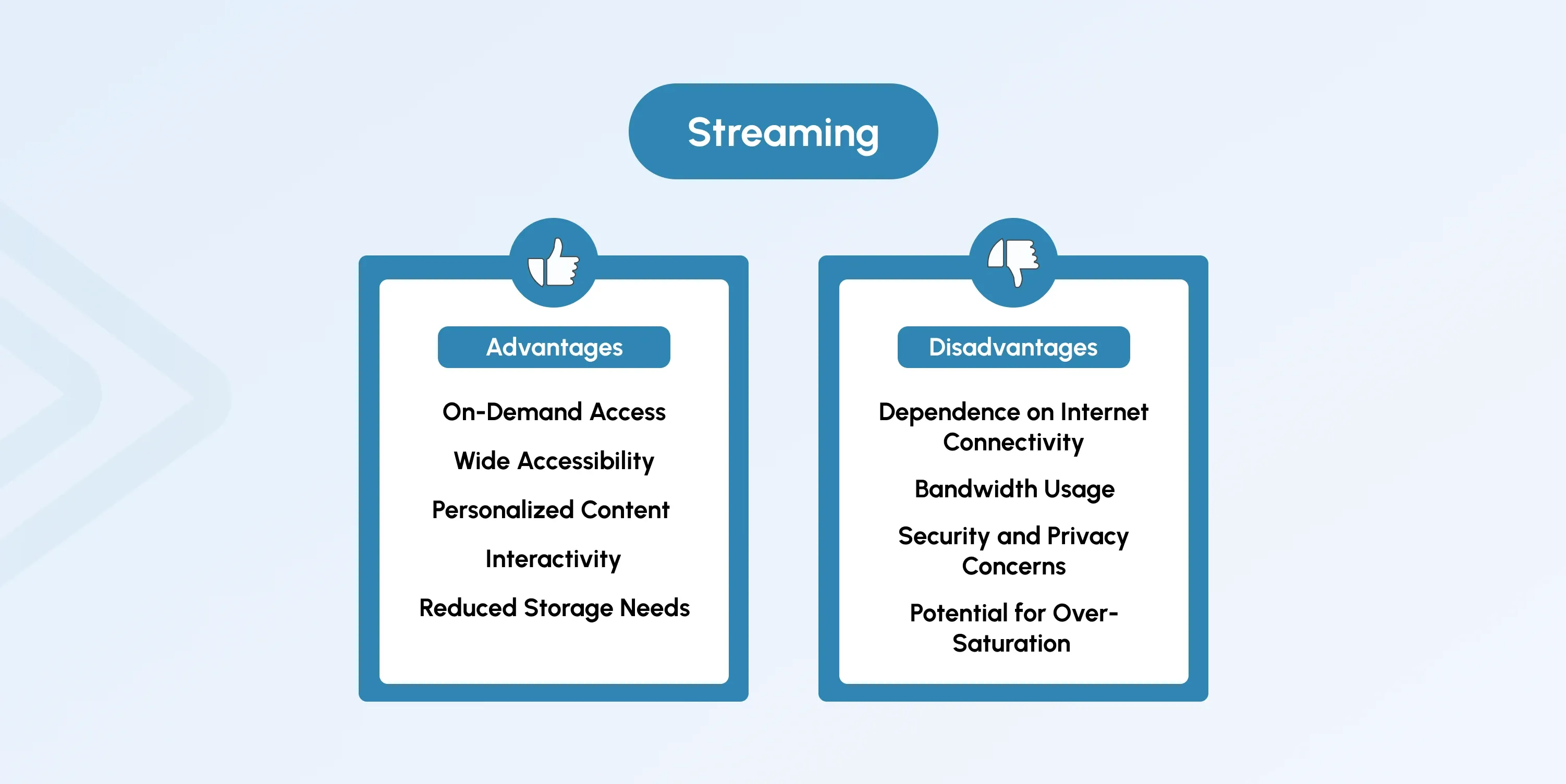
Cons
1. Dependence on Internet Connectivity
The foundation of streaming is internet availability. Users with slow or erratic connections may experience buffering, poor video quality, or interruptions, which can affect their viewing experience.
2. Bandwidth Usage
Streaming uses a lot of bandwidth, which could cause users on low data plans extra expenses or data cap problems. 4K or high-definition streaming might drive even more data use.
3. Content Licensing and Regional Restrictions
Licensing agreements restrict some streaming content to particular areas, therefore limiting availability to worldwide viewers. Users in some locations might not be able to access the whole spectrum of content on offer.
4. Security and Privacy Concerns
To offer tailored recommendations and advertisements, streaming companies compile user information. Unfortunately, this gathering of data may cause privacy issues, particularly in cases where insufficient security measures are used to protect user data.
5. Potential for Over-Saturation
Managing several subscriptions may be daunting for consumers, given the rising number of streaming services. Additionally, this oversaturation could increase expenses and cause viewers to experience decision fatigue.
Advantages and Disadvantages of Broadcasting
Pros
1. Wide Reach
For live events, news, and shows with broad appeal, broadcasting lets content reach big audiences concurrently. Its enormous distribution capacity helps it to be efficient in swiftly providing content to a large population.
2. No Internet Dependency
Traditional broadcasting (over-the-air, cable, or satellite) is accessible to those in places with little or no internet access since it differs from streaming in that it does not depend on internet availability.
3. Reliability and Consistency
Particularly for important updates like news, weather reports, and emergency broadcasts, broadcasting services usually have established infrastructures that guarantee dependable and continuous content delivery.
4. Cost-Effective for Viewers
Bundled with basic cable services, many broadcasting stations are free or available at a reduced price. Some viewers will find this more affordable than subscription-based streaming services.
5. Shared Viewing Experience
Since individuals all around witness the same shows in real-time, broadcasting usually promotes a shared watching experience. Common events like sporting events or big news stories can foster community-mindedness.

Cons
1. Lack of On-Demand Flexibility
Broadcasting has a set schedule that limits viewers' capacity to view content whenever it is most convenient. For viewers with different schedules, this dearth of on-demand choices can be frustrating.
2. Limited Personalization
Unlike streaming, broadcasting doesn’t provide recommendations or customized content. It's meant for a wide audience; hence, the content is broad rather than catered to personal tastes.
3. Higher Production Costs
Broadcasting usually entails substantial production and transmission costs, especially for live events. Smaller creators and companies may find these expenses less practical.
4. Geographic and Licensing Restrictions
Technical limitations or licensing agreements might restrict broadcast coverage to particular areas. This limits the worldwide availability of content, especially for local stations.
5. Low Interactivity
Real-time engagement tools like live chats or interactive feedback, common in streaming, aren’t provided by broadcasting. Direct viewer contact with the content or creators may thus be limited.
Start Streaming with inoRain’s White-Label OTT Solutions
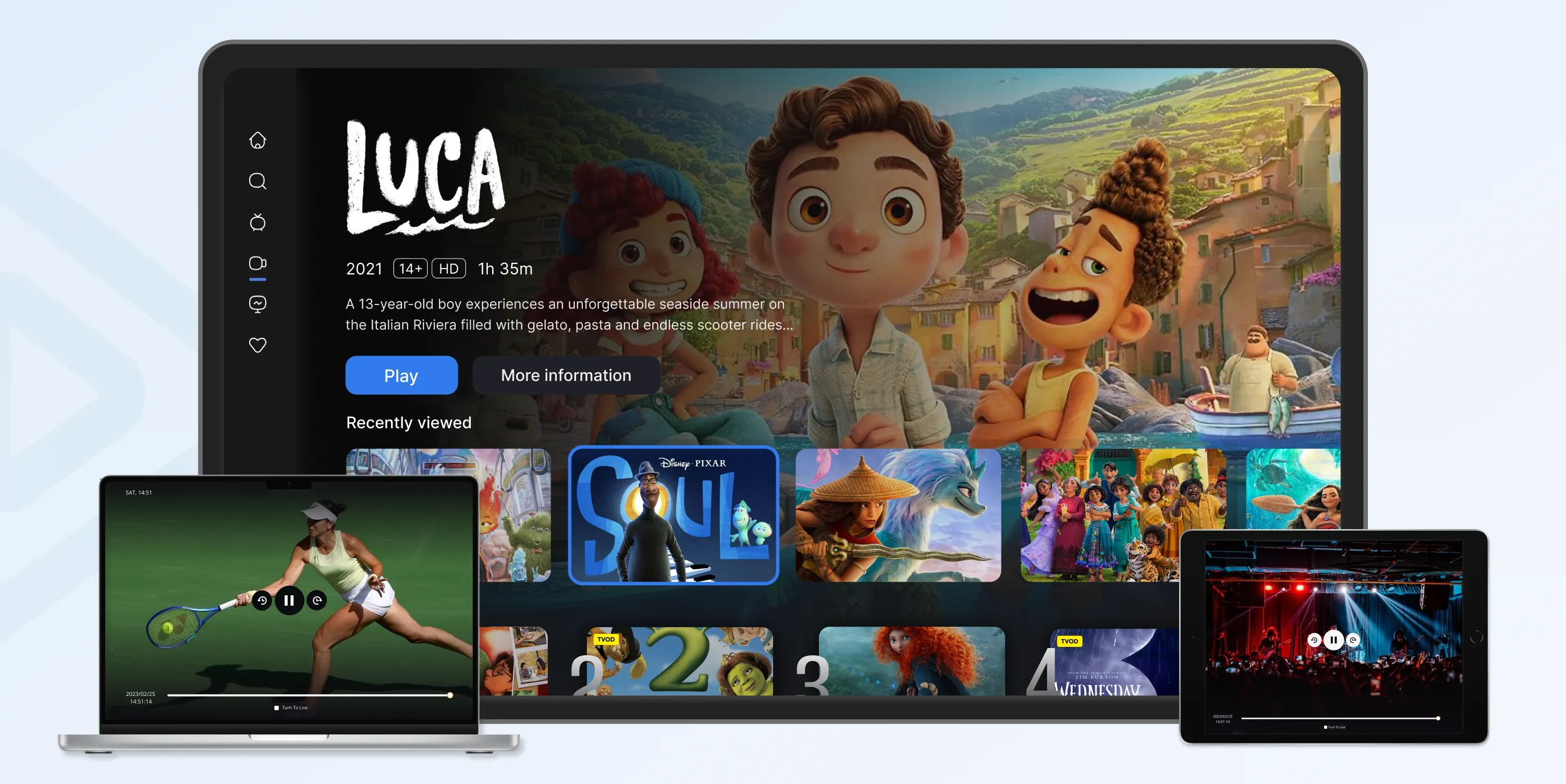 Designed to meet the needs of modern streaming businesses, inoRain’s OTT solutions provide an exceptional streaming experience for your end users.
Designed to meet the needs of modern streaming businesses, inoRain’s OTT solutions provide an exceptional streaming experience for your end users.
Here is what you get with inoRain:
- Adaptive Bitrate and Multi-bitrate Streaming
- Real-time statistics,
- High-quality playback
- Device Compatibility
- DRM Encryption
- Video Monetization
Let’s create scalable, flexible, high-quality streaming experiences that meet the needs of your target audience.
Get Your Custom OTT Solution Here
Conclusion
Over-the-top (OTT) platforms and content distribution methods, including broadcasting and streaming, have fundamentally changed how consumers access and engage with media.
Since both technologies have different advantages, you can use both to effectively reach various demographics.
If you need a more modern approach, streaming is what you need. Conversely, if your target audience prefers broadcasting, use it for higher user satisfaction.
Both technologies have different advantages; you can even use both to effectively reach various demographics.
FAQs
What is the main difference between streaming and broadcasting?
Streaming lets consumers view what they want when they want by delivering content over the internet on demand. Broadcasting makes content available to all devices tuned to the particular frequency or channel by sending it over cables or radio waves at set times.
Can streaming fully replace broadcasting in the future?
Although streaming provides flexibility and convenience, broadcasting is also important for rapidly reaching large audiences, like in an emergency. Since each has different uses, they probably will keep living together.
Is streaming better than broadcasting for live events?
With choices like on-demand replays, streaming offers interaction and flexibility; nevertheless, broadcasting usually has less latency, therefore it is best for real-time events like sports or news. Depending on the kind of event, each has its strengths.
Can a platform offer both streaming and broadcasting?
Yes, several platforms provide hybrid models that combine scheduled broadcasting with on-demand streaming to satisfy different audience needs and maximize reach over digital and conventional channels.
What does streaming cost?
While broadcasting calls for investments in spectrum licenses and equipment for transmission, streaming often entails infrastructure for online delivery, server costs, and licensing. Ultimately, scale and particular technologies employed determine the cost involved.
Co-founder / CTO
Hi, I'm Armen, the CTO and Co-Founder of inoRain OTT, as well as the Co-Founder of HotelSmarters. With 15+ years of background in digital streaming technology, I specialize in OTT strategies and interactive TV solutions, helping businesses maximize their revenue potential. At HotelSmarters, I focus on leveraging tech to transform hotel operations, while at inoRain, I drive innovation in end-to-end OTT solutions. Let’s connect and explore new opportunities!

OTT Advertising: Types, Best Practices, and Strategies
Over-the-top (OTT) advertising has transformed how brands connect with consumers.

VPlayed Alternatives: inoRain vs. VPlayed
Explore inoRain as a VPlayed alternative, comparing features, pricing, and OTT solutions to find the best platform for your streaming needs.

Custom OTT Platform Development: How to Start an OTT Business
This guide will walk you through everything you need to know about the OTT platform development.
